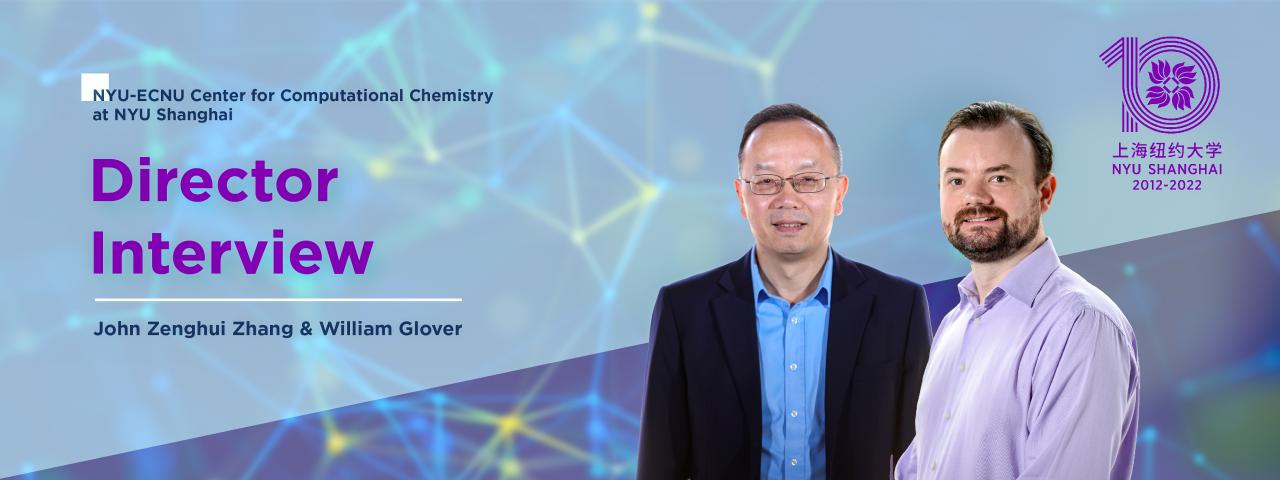
NYU-ECNU Center for Computational Chemistry at NYU Shanghai was established in 2013, concurrent with the establishment of NYU Shanghai. Recently, we spoke with the center’s Director John Zenghui Zhang and Associate Director William Glover to reflect on its decade-long development and their perspective on future research. “The trend is clear,” said Zhang. “Future solutions will arise from interdisciplinary collaborations. Breakthroughs will require interdisciplinary cooperation.”
What was the motivation for launching this center? How did the center go about to achieve its goals?
Zhang: To be candid, we’re a small-sized institution, so our approach for research development is to concentrate on areas where we can leverage our unique strengths. One such area is computational science, which can be developed with relatively fewer resources and can also benefit from collaboration with NYU New York and East China Normal University. When the center was established, our aim was to create an interdisciplinary and international platform for world-class research, to educate students and young scientists, and to facilitate international collaboration in computational chemistry-related fields.
Over the past decade, we have worked hard to achieve these goals through various initiatives. For example, we regularly host international conferences and invite both local and international scholars to share and exchange ideas. We also hold bi-weekly seminars that provide a platform for world-leading experts to present their research, and opportunities for collaboration are discussed.
Glover: As John mentioned, another focus for us is training students and young scientists. The center brings together researchers from various areas of computational chemistry, giving our students and postdocs a comprehensive understanding of the field.
In addition to our own Chemistry PhD Program and the NYU Shanghai - ECNU Joint Graduate Training Program (N.E.T.), we have also created a summer school called “NYU Shanghai Summer Undergraduate Research Experience Program in Molecular Science (SRPMS)”, which is open to students from around the world. Its purpose is to provide highly motivated undergraduates with a strong interest in chemistry, biology, or related scientific disciplines with a gateway into research-centered careers in these fields. We are planning to further develop this into a formal training program, providing trainees with not only hands-on research experience but also career advice and networking opportunities, creating a more comprehensive training experience.”
What is the center’s research focus and future planning?
Zhang: Our center focuses on theoretical and computational chemistry, with members conducting research in various fields such as quantum chemistry, large-scale biological computation, force field development, condensed matter molecular dynamics, and photochemistry. We’ve been expanding our research capabilities and strengthening our profile in the academic community over the years. With an average of over 70 papers published annually by our members in leading journals, we’re making an impact in the field of chemistry.
 Left: Simulation of protein motion in water; Middle: Protein-RNA interaction; Right: Protein-drug interaction
Left: Simulation of protein motion in water; Middle: Protein-RNA interaction; Right: Protein-drug interaction
Computational chemistry is just a small branch of chemistry, so it is crucial for us to collaborate with other disciplines. We believe that interdisciplinary research will be a major trend in the future. In the next decade, we hope to secure more resources and focus on expanding our interdisciplinary research areas.
Glover: To further this goal, we have established an interdisciplinary forum where faculty members from different fields can share their research and future plans, exploring potential overlaps, synergies, and collaborations. We are also applying for funding from the Shanghai Science and Technology Committee (STCSM) to support our collaborations with data science.
Why is it important to have interdisciplinary collaboration in the field of Chemistry?
Zhang: Chemistry is a pivotal science as it deals with molecules, which form the basis of almost all modern sciences. As a result, it has the unique ability to connect with various physical sciences, such as Material Science, Neuroscience, Biology, and Medicine. With the ongoing advancement of artificial intelligence, Chemistry is well-positioned to facilitate interdisciplinary interactions. Room for new discoveries in traditional sciences is getting limited. However, modern science is facing increasingly complex systems, particularly in life sciences, where breakthroughs require interdisciplinary efforts.
For instance, the development of AlphaFold by computer scientists, which can predict protein structures, is a prime example of interdisciplinary cooperation leading to significant progress. Chemistry, being at the center of various scientific fields, plays a crucial role in bridging different branches of science and driving new breakthroughs.
Glover: Having a fresh perspective from outside a field can often bring new ideas and provide solutions to long-standing problems. Collaborations are especially powerful because they bring together knowledge and expertise from multiple disciplines, which is essential in solving interdisciplinary problems.

